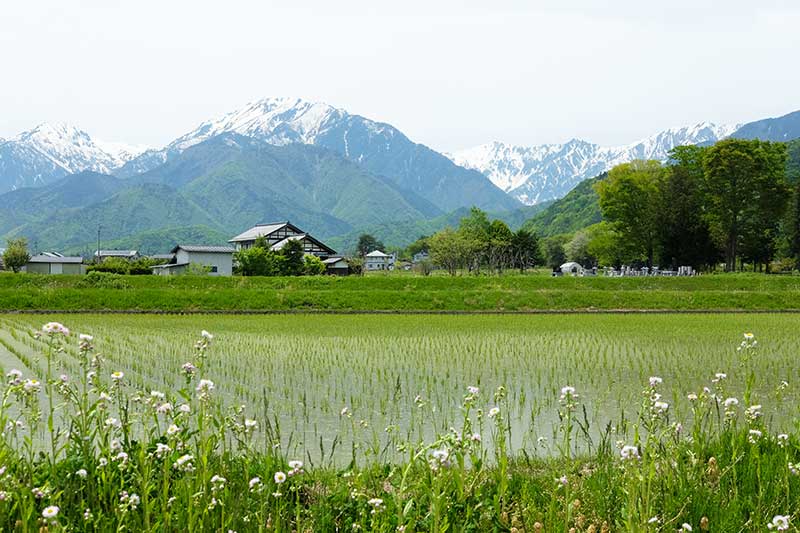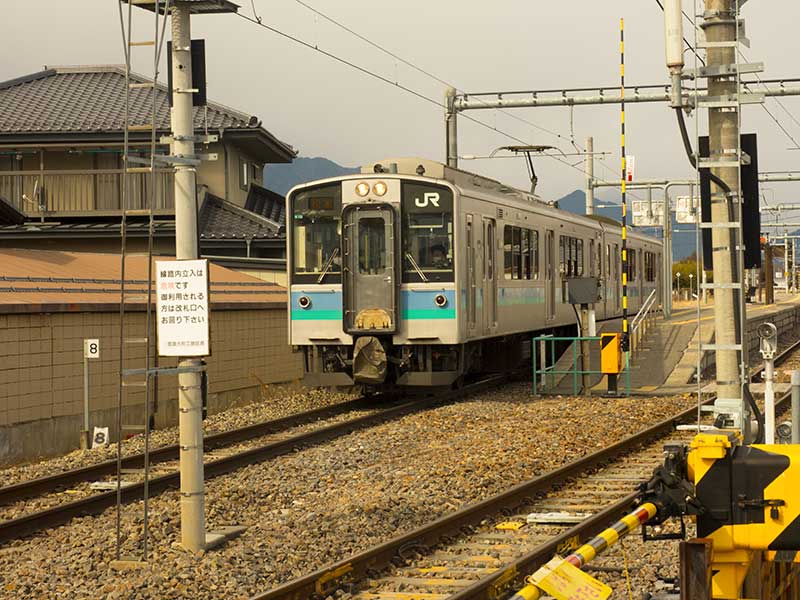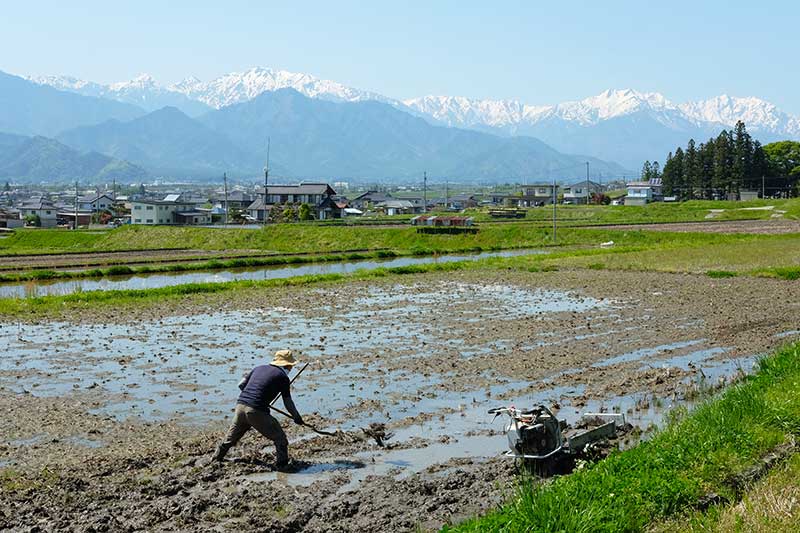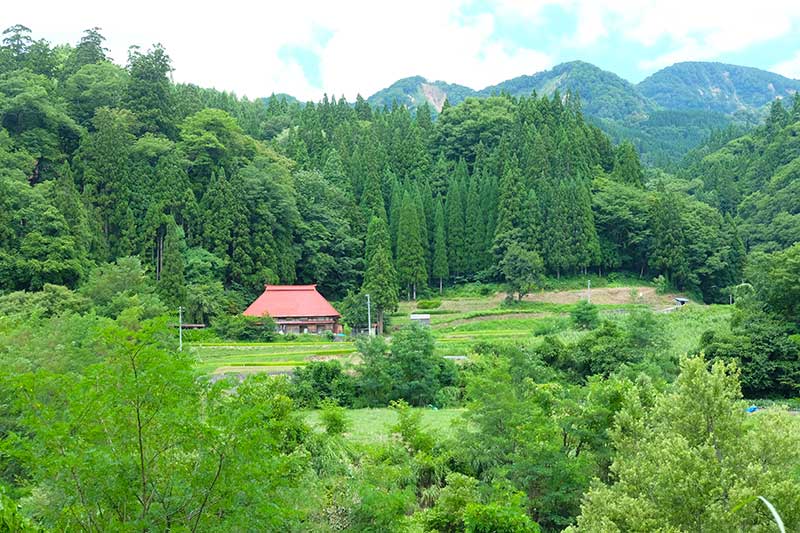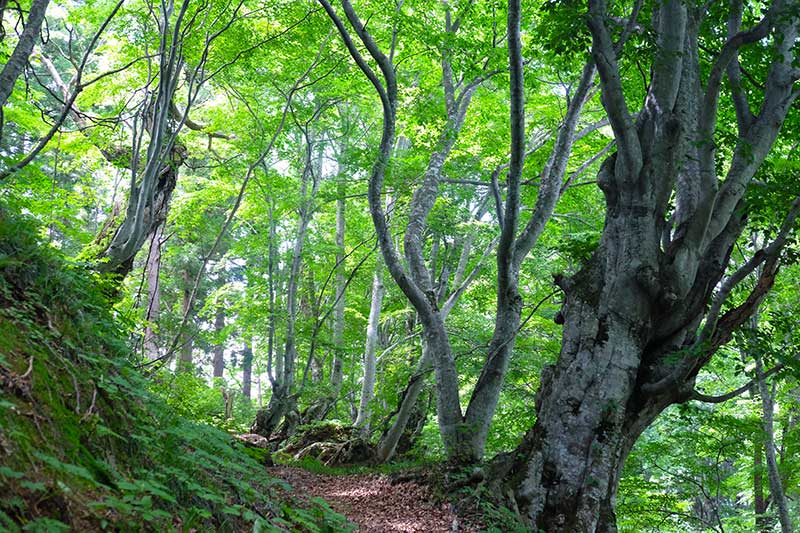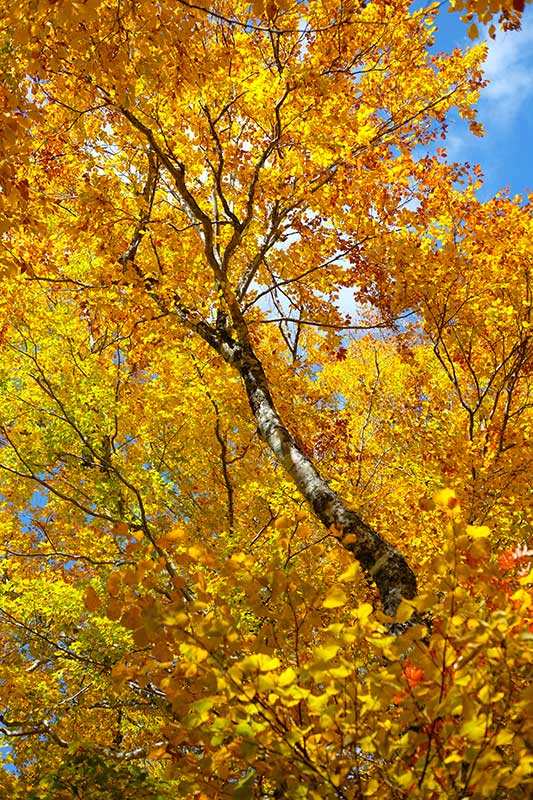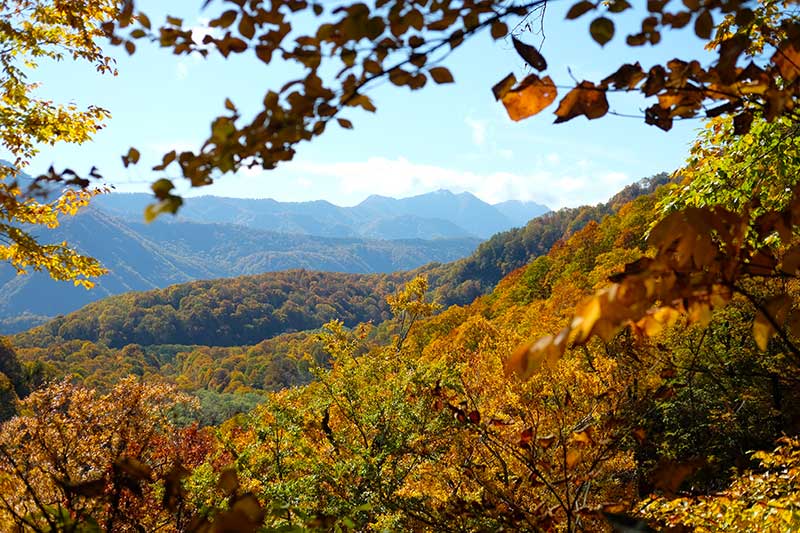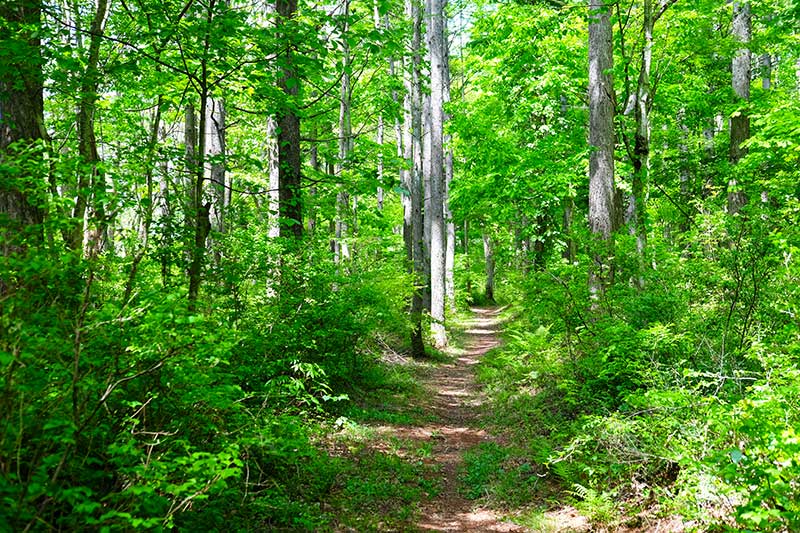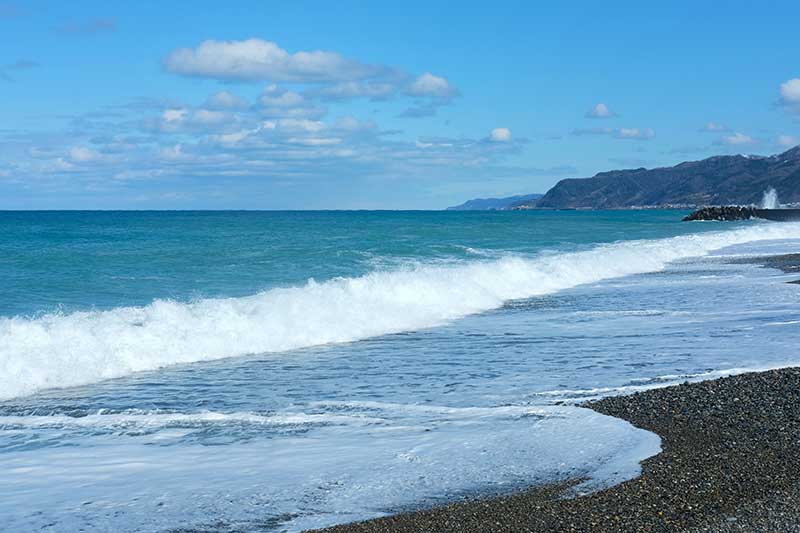A walking tour following the Salt Road, an old trading route in central Japan.
Guided exploration of the Shio-no-michi: Salt Road, one of Japan's old overland trading routes in Nagano and Niigata Prefectures; excellent walks along mountain trails once used by porters to transport merchandise, including salt, from the Sea of Japan to landlocked Matsumoto; atmospheric inns, ample and delicious mountain and coastal cuisine, onsen thermal hot spring baths.
May - June & September - November.
Tour accommodation is in hotels and Japanese inns. Please read more on accommodation here. The small, intimate nature of the inns makes the maximum group size 12 people. We have no minimum size. If we accept a booking we guarantee to run the tour.
Walk Japan’s Shio-no-Michi: The Salt Road tour takes us over the wide Matsumoto plateau, through deep valleys and over high passes surrounded by the soaring Japanese Alps in northern Nagano to the wild Sea of Japan coast in Niigata. We follow in the footsteps of bokka foot porters who literally shouldered the burden of providing vital supplies to Matsumoto, a strategically important but landlocked regional samurai stronghold, during the Edo Period (1603-1868). Any experienced trekker will thoroughly enjoy this historic trail, which provides excellent walking along deep valleys and over passes, through sleepy mountain villages and lushly green forests set against the beautiful backdrop of the Japanese Alps, the nation’s tallest mountain range. En route we pass myriad stone Buddha statues and ancient shrines, as we wend our way from one rural town to another, and one remote mountain hamlet to the next. The Shio-no-Michi: Salt Road tour immerses us in the society of a little visited but beautiful mountainous region, with a distinctively different culture and history. On our travels we enjoy a varied Japanese cuisine with ingredients sourced from the fertile plateau around Matsumoto, the mountains of central Japan, and the abundant Sea of Japan. Throughout our journey plentiful onsen hot spring baths are complemented by hearty local mountain cuisine, which is supplemented by deliciously fresh seafood as we approach the coast.
While the Nakasendo Way and Tokaido Trail, both from Kyoto to Tokyo, evoke the grand processions of princesses and feudal lords, the Shio-no-Michi, which literally means the ‘salt road’, connects us to a more ordinary past, particularly the lives of the bokka porters and local hyakusho farmers who laboured along or aside its route. It is easy to imagine, however, that their daily toil was relieved by the glorious surrounding landscape of oft snow-capped mountains, pristine buna beech forests and crystal-clear streams; a scene that often seems to be little changed to this day.
Formalised in the 16th Century, the Shio-no-Michi was used to transport vital supplies, including salt and fresh fish, approximately 105km from the bustling kitamae sea trading port at Itoigawa to the landlocked castle stronghold at Matsumoto. Tobacco, hemp, soya and washi paper were sent the other way. Bokka porters shouldered 60kg for their journeys and, although oxen were also used to transport goods, they came into their own when speedy delivery was required and in the long winter months when the trail was, and still is, submerged under some of the heaviest snowfall found anywhere in Japan.
Our exploration follows the Salt Road along quiet country lanes, forest trails and mountain paths from the vast agricultural plateau surrounding Matsumoto, via the foothills and remoter valleys of Japan’s Northern Alps before descending to the tour’s end by the Sea of Japan. It includes some steep climbs in mountainous terrain sometimes over uneven terrain and is recommended for fit individuals who are used to trekking. Please contact us for guidance if you are not sure whether this tour is suitable for you.

Please note that travel by Shinkansen bullet train from Itoigawa to Tokyo and then on by express train to Narita Airport is approximately 4.5 hours, and to Haneda Airport 3.5 hours. Travel to Nagoya by Shinkansen via Tokyo is approximately 5 hours. Travel by express via Osaka to Kansai Airport is approximately 4.5 hours.
Day 1 Matsumoto
Our tour starts in Matsumoto, an elegant city situated on a high plateau surrounded by mountain ranges, including the magnificent Japan Alps. Your Walk Japan tour leader awaits you at 15:00 in the lobby of our hotel for a venture to Matsumoto Castle, the city’s emblematic and historic imposing symbol. Later, your Tour Leader provides the tour briefing over dinner at a lively izakaya restaurant, a popular destination for many Japanese where the large and varied menu is sure to cater to everyone’s tastes.
Accommodation: Western-style hotel.
Meals: Dinner provided.
Total walking: 2km (1.3 miles), 1.5 hours.
Total elevation gain: N/A.
Day 2 Matsumoto – Ikeda – Omachi Onsen
After breakfast in our hotel, we send our main luggage off ahead of us before strolling through Matsumoto’s city centre to its main railway station. En route, we make a brief stop at a street corner where we find a small unassuming rock. Known as the Ushi-tsunagi-ishi, which when rendered into English is a less attractive sounding ‘cow post’, this diminutive and easily overlooked stone marks the end of Shio-no-michi: Salt Road and the final destination of porters carrying the mineral over the centuries. For us, however, it acts as the starting point of our journey in the opposite direction to the Sea of Japan.
A charming single carriage, local train takes us on a leisurely 45-minute train ride wending through Matsumoto’s suburbs, small neighbouring towns and rice paddies on a route loosely paralleling the Salt Road. We disembark at a quiet station and soon after join the Salt Road to begin our walk in earnest. This railway line, in fact, largely follows the Salt Road all the way to Itoigawa, where we finish our tour, and en route we frequently cross paths with it.
Our path today is along paved roads with flatter terrain that traces a route along the lower slopes of a hillside allowing us spectacular views over the surrounding countryside to a dramatic backdrop of Japan’s towering Central Alps. Following quiet country lanes we pass aside rice paddies, farmhouses with their neatly tended gardens, ancient rural Shinto shrines, and numerous stone guardian deities placed to protect residents and travellers alike. En route, we enjoy a delicious picnic lunch.
We complete today’s walk in a thicket of ancient trees, some of the most venerable we come across on our travels, in the grounds of Nishina Shinmeigu. This shrine is a National Treasure built in the ancient Japanese architectural style typical of the famed Grand Shrine at Ise, Japan’s holiest site. From here a vehicle transfers us on a short journey to our accommodation for the evening, an elegant modern onsen ryokan. Our main luggage, which we sent from Matsumoto this morning, awaits our arrival.
After relaxing in the onsen baths, which includes a rotenburo outdoor bath, we settle down together to enjoy our evening meal. A sumptuous multi-course affair, it is composed of seasonal fayre from the surrounding valleys, rivers and the Sea of Japan.
Accommodation: Japanese-style hotel with onsen hot spring baths.
Meals: Breakfast, lunch & dinner provided.
Total walking: 12km (7.5 miles), 4 hours.
Total elevation gain: 221m (725ft).
Day 3 Omachi Onsen– Omachi – Hakuba
In a routine common to the rest of the tour, after breakfast we send our main luggage ahead before taking a short minibus ride to Omachi, once a thriving post town on the Salt Road. Here the surrounding mountains that had provided us with an impressive distant backdrop yesterday now encroach closely narrowing the plateau. In this historic town we find Chojiya, the old home and business premises of a local salt merchant. Preserved much as it was in the heyday of the Salt Road, it provides us with entertaining insights into life on the old road, the life of the merchant and bokka porters, who would be relieved of some of their load here.
We next board a train from the local railway station for a short transfer to the shore of the first of three lakes, Kisaki-ko, that we skirt today. From here on the mountains close in further, the valley narrows and, as the plateau finally tapers out, we begin our significant first climb of the tour. Cresting a low pass the next two lakes, Nakazuna-ko and Aoki-ko, follow in quick succession. En route we stop to enjoy a picnic lunch.
We end our walk at the source spring of Himekawa, a crystal clear river that flows north to the Sea of Japan and intersects frequently with the Salt Road for the rest of our tour. From here a short transfer by vehicle brings us to our accommodation in Hakuba, an internationally famed ski resort that hosted the 1998 Winter Olympics. We are now deep in Japan’s Northern Alps where, in winter, snowfall reaches 11 meters and more. During our visit, however, the snow has retreated to the peaks of the highest mountains providing us with classic alpine views.
Accommodation: Lodge with onsen hot spring baths.
Meals: Breakfast, lunch & dinner provided.
Total walking: 11.7km (7.3 miles), 5-6 hours.
Total elevation gain: 113m (371ft).
Day 4 Hakuba – Kudarise Onsen
Today, the Salt Road takes us deeper into the Northern Alps along forest trails, over streams and through wayside hamlets. Buddhist statues are plentiful and hearten us as we make our way. In a delightful rural setting we come across Ushikata-yado, the last existing structure of many, once found not only on the Salt Road but throughout Japan, that provided sanctuary for both porters and oxen. A little further on we find the reconstruction of a guard station, which once stood across the old road here. An outpost of the daimyo samurai lord of Matsumoto, this checkpoint controlled the passage of all travellers and extracted tolls on them and any merchandise they were carrying.
Our path continues on through undulating terrain, through hamlets, and past solitary farmhouses, wayside shrines and Buddhist statues, before ending in Kudarise Onsen at the centre of Otari, a district at the very northern end of Nagano Prefecture. Our accommodation tonight is in a Japanese-style hotel with onsen hot spring baths, set aside a river, the Himekawa, in a deep valley. After a relaxing and reviving soak, we dine on local cuisine that draws on ingredients foraged from the surrounding mountains.
Accommodation: Japanese-style hotel with onsen hot spring baths.
Meals: Breakfast, lunch & dinner provided.
Total walking: 14.4km (9.0 miles), 5-6 hours.
Total elevation gain: 444m (1,457ft).
Day 5 Kudarise Onsen – Nakatsuchi – Otari Onsen
Along with neighbouring Hakuba, Otari is one of the snowiest areas of Japan. It is also known for its steep terrain, unstable geology and the ravages wrought upon it over millennia by river waters of the Himekawa when in flood. Passage at times was so difficult that from here north over the prefectural border into Niigata the Salt Road braids providing a variety of alternative routes.
Unless weather conditions preclude it, our journey takes us along the oldest and highest route. Used since the Nara Period (710-794), the lower reaches of this path is dotted with quiet mountain hamlets, where every house sports steeply gabled roofs reminding us of how snowy the winters are here. At higher elevation, it takes us through exquisite buna beech forests. Despite the difficult terrain and tough winters, Otari is popular with Japanese looking for a rural life. Many have settled in the area and we enjoy lunch in a café run by newcomers.
After lunch, we transfer to around 1,000m above sea level for our afternoon walk through a beech forest to Kamaike, a beautiful serene emerald green pond. Here Amakazari (1,963m), one of Japan’s 100 famous mountains, towers above us. We follow a steep trail down to the end of the walk at our accommodation, where we enjoy onsen baths and a delightful evening meal before settling in for the night.
Accommodation: Traditional Japanese inn with onsen hot spring baths.
Meals: Breakfast, lunch & dinner provided.
Total walking: 8.8km (5.5miles), 5-6 hours.
Total elevation gain: 377m (1,236ft).
Day 6 Otari Onsen – Fukahara – Himekawa Onsen
After a traditional Japanese breakfast, we return by vehicle to Fukahara to rejoin our path on the Salt Road for the longest and most rigorous walk of our tour. As the trail here is long and fragile, we welcome a local guide to help us safely negotiate the terrain today.
Similar to yesterday’s scenery, our path leads us as we climb from one remote hamlet to another over mountain streams and through more beautiful buna beech forests. A sure footing is required in places and it is incredible to know that the porters who once walked this narrow path carried burdens up to 60kg even in the depths of very hard winters. We, however, carry only the barest minimum weight on our ascent, which is rewarded at Jizo Toge, a high pass where, on clear days, we soak up the spectacular views of mountain upon mountain disappearing into the distance.
Our descent takes us through lush forests to a mountain road where we board a waiting vehicle for the short journey to our accommodation, a hotel with more relaxing onsen baths, aside the Himekawa, a picturesque mountain river. Tonight is the first of two nights we stay here. Between us and the river runs the single track railway line, which we have closely followed since riding it on Day 2 from Matsumoto. At irregular intervals the one-carriage train making its way along the tracks adds a delightful frisson to the already scenic atmosphere.
Accommodation: Onsen hot spring resort.
Meals: Breakfast, lunch & dinner provided.
Total walking: 8.3km (5.1miles), 6-7 hours.
Total elevation gain: 764m (2,506ft).
Day 7 Himekawa Onsen – Oami – Himekawa Onsen
After breakfast in our inn, we transfer by vehicle to Oami, which used to be a busy post town on the Salt Road but now caters to few visitors besides walkers like ourselves. From here the Salt Road winds up and down through glorious forests of buna beech and tochi horse chestnut trees. After crossing a suspension bridge, the climb steepens as we climb up to the highest pass for today, the Oami Toge. In the Salt Road’s heyday, this pass was home to tea houses, inns for porters and stabling for oxen, but today there are no remaining buildings and usually no one else, other than ourselves, to disturb the calm of the mountains.
Our descent takes us into Niigata Prefecture and soon afterwards we have our first glimpse of the Sea of Japan. As we continue walking we come to Shiroike, a beautiful pond the surface of which reflects the backdrop of Amakazari, the region’s iconic mountain. Soon afterwards we find ourselves aside a huge ancient cedar tree, which used to be a route marker for the porters making their way up from the valley below. Just beyond is Nechi, where we visit another modest and charming museum dedicated to the Salt Road. Once threatened with closure by the local administration, villagers volunteer to keep it open to the public. From here we transfer back to our accommodation beside the Himekawa for our second evening.
Accommodation: Onsen hot spring resort.
Meals: Breakfast, lunch & dinner provided.
Total walking: 10.5km (6.5 miles), 5-6 hours.
Total elevation gain: 775m (2,543ft).
Day 8 Himekawa Onsen –Itoigawa – Sasakura Onsen
After breakfast in our accommodation, we begin our last full day together with a relaxing stroll through rolling countryside as we approach the Sea of Japan. We transfer back to Nechi and the start of our walk where we can enjoy the wonderful views of the mountains we have negotiated during our tour together. Nearby is Fossa Magna, a tectonic fault line that splits Japan into East and West. This has been the major source of the geological fragility we experienced along the Salt Road in Otari.
Along the way, we enjoy lunch at a delicious and welcoming local restaurant before we finally arrive at Itoigawa. Today a subdued town on the Sea of Japan coast, In the Edo period, Itoigawa was a port for the Kitamae-bune trading ships that plied between Osaka and Hokkaido via the Seto Inland Sea and the Sea of Japan. Our walk ends by an ancient stone marker that indicates the starting point of the Salt Road. We walk a little further to the coast, where waves break in a crescendo on the beach.
We transfer by vehicle to Sasakura Onsen where we are warmly welcomed by our hostess and her staff at the final accommodation, a modern inn, of our tour together. A luxurious soak in the onsen baths is followed by our final dinner, a lavish seafood banquet, of the tour together.
Accommodation: Modern Japanese inn with onsen hot spring baths.
Meals: Breakfast, lunch & dinner provided.
Total walking: 11.7km (7.3km), 5-6 hours.
Total elevation gain: 239m (784ft).
Day 9 Sasakura Onsen - Itoigawa
After breakfast, the group transfers together to Itoigawa Station, where the tour ends. Your tour leader will be on hand to help you purchase onwards train tickets to Tokyo, Kyoto, Osaka and beyond.
Accommodation: N/A
Meals: Breakfast provided.
Total walking: N/A
Total elevation gain: N/A.
This itinerary is subject to change.
The major international airports convenient for the tour's start at Matsumoto are Tokyo’s Narita and Haneda Airports, Nagoya’s Chubu Airport and Osaka’s Kansai Airport.
-----
FROM TOKYO’S HANEDA AIRPORT (HND)From Tokyo’s Haneda International Airport, transfer by the Tokyo Monorail or Keikyu Railway and then JR line trains to Shinjuku Station, from where Azusa Express trains depart for Matsumoto. The journey costs about JPY9,000 per person and takes approximately 3.5 hours. From Matsumoto Station, take a taxi or walk to the accommodation.
-----
FROM TOKYO’S NARITA AIRPORT (NRT) From Tokyo’s Narita International Airport, Narita Express trains depart to Shinjuku Station, from where Azusa Express trains depart for Matsumoto. The journey takes approximately 4.5 hours. From Matsumoto Station, take a taxi or walk to the accommodation.
-----
FROM NAGOYA’S CENTRAL JAPAN INTERNATIONAL AIRPORT (NGO) From Nagoya’s Central Japan International Airport, Meitetsu Line trains depart to Kanayama. Change here to the JR Line and board the Shinano Express train for Matsumoto. The journey takes approximately 2.5 hours. From here, take a taxi or walk to the accommodation.
-----
FROM OSAKA’S KANSAI INTERNATIONAL AIRPORT (KIX) From Osaka’s Kansai International Airport, Haruka Express trains depart to Shin-Osaka Station. Change here to the JR Line and board a shinkansen bullet train for Nagoya, from where Shinano Express trains depart for Matsumoto. The journey takes approximately 4 hours. From here, take a taxi or walk to the accommodation.
-----
The pre-tour pack includes detailed instructions, including a map, for travel to the accommodation at the start of the tour.
Please note that the journey at the end of the tour by shinkansen bullet train from Itoigawa to Tokyo and then on by express train to Narita Airport is approximately 3.5 hours, to Haneda Airport 3 hours. Travel to Nagoya by shinkansen via Tokyo is approximately 4.5 hours. Travel by express via Osaka to Kansai Airport is approximately 5 hours.


